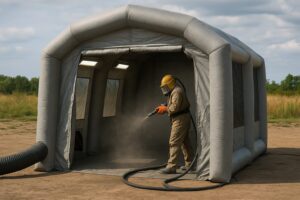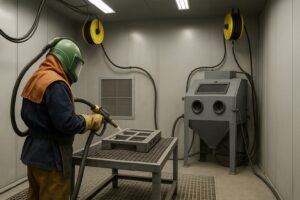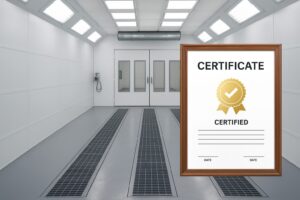When it comes to refinishing surfaces in a paint booth, understanding cure time is crucial. Whether you’re spraying automotive parts, industrial components, or decorative items, knowing how long paint needs to fully cure helps you plan production schedules, ensure quality finishes, and avoid costly rework. Today, we’ll break down the basics of paint curing inside a booth, explore the factors that influence cure times, and share practical tips for getting the most consistent results.
What Is Paint Curing?
Curing refers to the chemical processes that transform liquid paint into a hard, durable coating. Unlike drying, which simply removes solvents, curing involves polymerization, where resin molecules link together to form a strong, cross-linked network. Proper curing ensures the coating resists scratches, chemicals, and environmental wear. In a controlled booth environment, temperature, airflow, and humidity all play roles in how quickly and effectively this transformation occurs. A well-cured finish not only looks better but also lasts longer under tough conditions.
Key Factors Affecting Cure Time
The following are the key factors that majorly affect the cure time:
Paint Type
- Single-Stage Paints: Combine color and clear coat in one formula. They typically cure faster, often in as little as 20–30 minutes at moderate bake temperatures but may offer slightly less depth of finish.
- Basecoat/Clearcoat Systems: A base layer provides color, followed by a clear topcoat for gloss and protection. Clearcoats, with their higher resin content, often require longer bake times to reach full hardness.
- Two-Component (2K) Coatings: Require mixing paint with a hardener just before application. Hardener choice (fast, standard, or slow) dramatically influences cure time and pot life.
Temperature
Paint booths often use bake cycles to accelerate curing. Typical temperatures range from 140°F to 180°F (60°C to 82°C). Higher heat speeds up chemical reactions, cutting cure times by hours. However, excessive temperatures can cause defects like runs, cracking, or discoloration. Always follow the manufacturer’s recommended bake schedule for each product.
Airflow and Ventilation
Even airflow distributes heat uniformly and removes solvent vapors. Proper booth ventilation prevents areas of stagnant air where curing may lag. Make sure filters are clean, fans are balanced, and intake/exhaust vents are clear of obstructions.
Film Thickness
Thicker coats trap solvents inside, slowing polymerization and risking surface defects. Applying multiple thin layers with proper flash times between coats yields a smoother finish and more uniform cure than one heavy pass.
Humidity
High humidity slows solvent evaporation and chemical reactions, extending cure times. Many booths include dehumidification controls. If yours does not, consider portable dehumidifiers or desiccant systems to maintain optimal moisture levels.
Typical Cure Times in a Paint Booth
While exact times vary by product and setup, these guidelines offer a ballpark for common coatings baked in a heated booth:
- Single-Stage Enamels: 20–30 minutes at 140°F (60°C)
- 2K Acrylic Urethanes: 30–45 minutes at 150°F (65°C)
- Basecoat Only (Air-Dry): 8–12 hours at room temperature (68–72°F / 20–22°C)
- Clearcoat (Air-Dry): 12–24 hours at room temperature
- Basecoat/Clearcoat Bake Cycle: 20–30 minutes at 160°F (71°C)
Air-dry cures (no bake) can stretch into days before paint reaches handling strength, and solvents can continue off-gassing for up to a week. If you need immediate handling, bake curing is almost always the better choice.
Why Overlooking Cure Time Can Cost You
- Poor Durability: Under-cured paint remains soft, making it prone to scratches, stains, or peeling.
- Solvent Pop and Blistering: Trapped solvent can vaporize during a rushed bake cycle, leading to bubbling defects.
- Inconsistent Gloss and Color: Incomplete polymerization can leave a dull sheen or uneven hue across a part.
- Rework and Downtime: Scrubbing off failed finishes and restarting the process eats into your schedule and budget, sometimes doubling labor costs.
Practical Tips to Optimize Curing
The following are the tips you can use to optimize the curing process.
Follow the Technical Data Sheet (TDS)
Every paint line provides detailed bake schedules, temperature ranges, and mixing ratios. Strict adherence is the easiest way to hit target cure times and avoid finish failures.
Monitor Booth Conditions
Install temperature and humidity sensors in multiple zones. Logging this data helps identify hotspots, cold spots, or moisture issues before they compromise large batches.
Calibrate Your Oven Regularly
Over time, booth heaters and fans may drift from their setpoints. Routine calibration ensures the actual temperature matches what the controller displays, so you bake at the right heat.
Plan Your Workflow
Stagger jobs to maximize booth usage. While one batch bakes, prep the next set of parts, cleaning, masking, or priming them so the booth never sits idle.
Use Flash-Off Areas Properly
After each coat, allow parts to flash in a dedicated zone. This helps solvents evaporate evenly before a bake cycle, reducing the risk of trapped moisture and solvent pop.
Invest in Infrared (IR) Curing
For fast-turnaround shops, IR lamps can target heat to specific areas, speeding cure without overheating the entire booth. This is especially useful for spot repairs or small parts.
Run Test Panels
Before committing to a full production run, test your bake time and temperature on scrap panels. Inspect for hardness, adhesion, and finish quality to validate your settings.
Balancing Speed and Quality
It’s tempting to ramp up temperatures or shorten bake times to meet tight deadlines. However, curing too quickly can induce stress in the coating, risk solvent entrapment, and yield finishes that look good initially but fail in service. Conversely, overly conservative schedules waste energy and reduce throughput. The sweet spot lies in precise control of temperature, airflow, and timing, guided by paint manufacturer specs and your own real-world test data.
Air-Dry vs. Bake Curing: Choosing the Right Method
Air-Dry
– Ideal for small touch-ups, decorative finishes, or heat-sensitive substrates.
– Requires longer staging areas and careful environmental control.
Bake Cure
– Standard for automotive, industrial, and heavy-duty applications.
– Delivers faster throughput and consistent, durable results.
– Parts must tolerate elevated temperatures without warping.
Conclusion
Achieving a flawless, durable paint finish in a booth isn’t just about choosing the right color or spray gun it depends on understanding and respecting cure times. By accounting for paint chemistry, temperature, airflow, humidity, and film build, you can optimize each bake cycle for consistent, high-quality results. Well-cured paint not only looks better it stands up to wear, chemicals, and the elements for years to come.
Ready to streamline your paint booth operations? Contact our experts today to learn more about booth calibration, cure cycle optimization, and top-quality coatings tailored to your needs.
How We Can Help with Your Paint Booth Needs
At Paint Booth, we specialize in providing top-tier paint booths and finishing equipment tailored to your business requirements. Whether you need a standard-size paint booth or a custom solution designed for your unique projects, our expert team is here to assist you every step of the way. From design to installation, we ensure that your equipment meets the highest industry standards, enhancing both your productivity and the quality of your finishes. Contact us today to find the perfect paint booth solution for your business!




